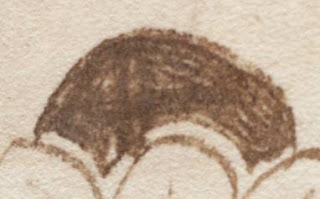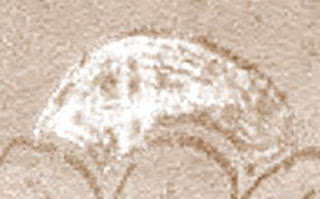Not long ago, I mentioned here that I had made a fist-punching-in-the-air breakthrough in my research, and promised to describe it more fully at a later date. Well, that later date has (thanks to a torrent of two gently chiding emails chivvying me along) now arrived: here’s what I found.
Regular Voynich News readers will by now be aware that I’ve spent a long time this year slowly trawling through various volumes of Lynn Thorndike’s vast “History of Magic & Experimental Science”. Given that I believe the Voynich Manuscript is an enciphered book of proto-scientific secrets rooted in Italian Quattrocento culture, Thorndike’s general focus on Italian scientific documents of the 14th (Volume III) and 15th (Volume IV) centuries is pretty much spot on. This approach has turned up a whole set of research leads to follow up over the next few weeks and months… so far so good.
But I also (sad completist I sometimes tend to be) picked up a copy of Thorndike’s rather less-well-known “Science & Thought In The Fifteenth Century” (1929, Columbia University Press): in which I found something pleasantly unexpected. But I’ll fill in all the background first…
Once upon a time (oh, in 2006), I wrote & published a book called “The Curse of the Voynich“, which described how I concluded from my meticulous codicological study that Quattrocento Florentine architect Antonio Averlino (better known as “Filarete”) was probably both the author and the encipherer of the Voynich Manuscript. Part of the textual evidence revolved around a set of “small works” to which Averlino alluded in his larger libro architettonico, and which I suspected were at least in part enciphered in the VMs. However, art historians have long disagreed about whether these other works actually existed, or whether they were just added in for spice to amuse Averlino’s (hoped-for) ducal audience: as far as anyone, there has long been no external evidence either way.
But then on p.219 of Thorndike’s “Science & Thought”, in chapter XII which is largely devoted to Giovanni Michele Alberto of Carrara’s “De constitutione mundi“, I found the following:
Antonio Averlino Filarete (1410-1470), who is commonly thought of as an architect and sculptor, is listed by John Michael Albert [i.e. Giovanni Michele Alberto da Carrara] among writers on plants as having treated that subject “elegantly in the vernacular tongue”. [94]
Thorndike’s footnote 94 then says:
Ibid. [MS Ashburnham 198], fol.78r: “Sed et Antonius Averlinus Philaretus lingua vernacula scripsit eleganter.” The work of Filarete on architecture was first printed only in 1890 (W. von Oettingen). In it he alludes to his work on agriculture, which is probably what John Michael Albert has in mind. See M. Lazzaroni and A Munoz, “Filarete, scultore e architetto del sec. XV”, 1908, p.281.
Somehow this whole mention appears to have gone unnoticed by all recent writers on Filarete: yet its existence would seem to strongly tip the balance of probability towards the likelihood that he did actually write his “other little works”. Hence why finding it was so rewarding (for me, at least).
Incidentally, MS Ashburnham 198 (one of the 11,000 manuscripts held by the Biblioteca Medicea Laurenziana in Florence) was dedicated to Boniface, marquis of Montferrat: and so was probably written between 1483 (when Bonifazio Palaeologo became marquis) and 1488 (when Alberto was given the title Count Palatine by Frederick III) or 1490 (when Alberto is thought to have died).
I then wondered where Alberto might have seen Filarete’s herbal manuscript. Alberto was born in Bergamo, trained in Padua, returned to Bergamo, and practised medicine at Rovato, Brescia, Chiari: and for a time was private physician to Roberto di Sanseverino, as well as Prior of the College of Physicians in Bergamo. I’d therefore guess that Alberto probably saw Filarete’s work (and perhaps even had a copy made of it) while in Bergamo, where he spent most of his life, only 50km or so from Milan where Filarete was working: or he may even have met Filarete, who is believed to have designed the plans for Bergamo Cathedral circa 1459, and who doubtless visited Bergamo on several occasions.
It would be amazing if Filarete’s elegant vernacular work on plants (or even just its incipit) could be identified: and so I started, emboldened by the archival research content of Day Three of the Warwick/Warburg Course, to think about where I might search (and for what, and for how long).
Identifying herbals from purely written descriptions is not unprecedented. In Thorndike’s “History of Magic & Experimental Science” Vol.IV (p.599), he describes Pandolphus Collenucius of Pesaro learning about herbs in Venice: “There in the street of the spice-dealers in a shop having as its sign the head of an Ethiopian he had consulted an herbal in which the plants were represented so carefully and artfully that you would have thought they grew on its pages.” In a footnote, Thorndike notes that Valentinelli (1872) “has shown that this was the De Simplicibus of Benedetto Rinio, with pictures of the plants by the Venetian painter, Andrea Amadio. The MS is now S. Marco VI, 59 (Valentinelli, XIII, 10).” All the same, we really don’t yet have enough to work with in the present case.
Where did Alberto’s belongings go after his death? Sergio Toresella tells me that Apostolo Zeno (1668-1750) wrote: “I understand that this Alberti was an humanist that wrote a lot of comedies and poetry but I do not know were his belongings went after his death.” So at least I’m not the first to ask!
But all is not lost: the Biblioteca Angelo Mai in Bergamo has a good collection of his letters and notes, and many manuscripts from his personal library (and so with his initials and coat of arms added to them). The library’s bibliographical description of its various humanistic documents taken from Kristeller’s Iter Italicum and Iter Supplementum is here. But, as Sergio points out, none looks particularly promising, with the possibly exception of MA 184-186 folio 8v “Ex experimentis et secretis magistri Guelmi” (though this too seems fairly unlikely).
There are some books on Alberto’s work. For instance, a 20th century academic called Giovanni Giraldi seems to have spent his life editing and publishing papers on him in obscure journals, many of which are reproduced in his 1967 book “Opera poetica, philosophica, rhetorica, theologica” (Novara: Istituto Geografico de Agostini): although none appears to be for sale online (boo), WorldCat lists 5 or 6 copies, one in the Warburg Institute (hooray!)
For Alberto’s life, there is “Giovanni Michele Alberto Carrara” by Ercole Vittorio Ferrario and Gian Camillo Donadi (1964), for which WorldCat lists just one copy (boo)… in the Wellcome Institute Library in London, just around the corner from the British Library (phew!). I’ve been meaning to go there for a while, partly to take a picture of its necromantic painting depicting John Dee (but that’s another story).
Interestingly, the Biblioteca Medicea Laurenziana makes a log of everyone who examines each of its manuscripts available on its website. Of the ten people listed for MS Ashburnham 198, there is someone from the Warburg Institute (in Hamburg!) in 1930, Patrick McGurk from the Warburg (in London) in 1953, Federici Vescalini Graziella in 1987, John Monfasani in 1995, and Ulrich Pfisterer in 1998, though I don’t yet know if Ulrich (who has written papers on Filarete) was or is aware of the mention on f78r: I’ll ask him, see what he says…
As far as the Voynich Manuscript goes, there’s always the tiny possibility that multispectral imaging of its very first page might just (if Alberto just happened to end up owning it) reveal a faint contact transfer from Alberto’s coat of arms and initials. But I’m more interested in seeing if the incipit is anywhere to be found: that would be far more useful for trying to break its cipher.
All of which may not seem like much to get hugely excited about, but it is a step forward (though admittedly only at the glacial pace normal for Voynich research). *sigh*




